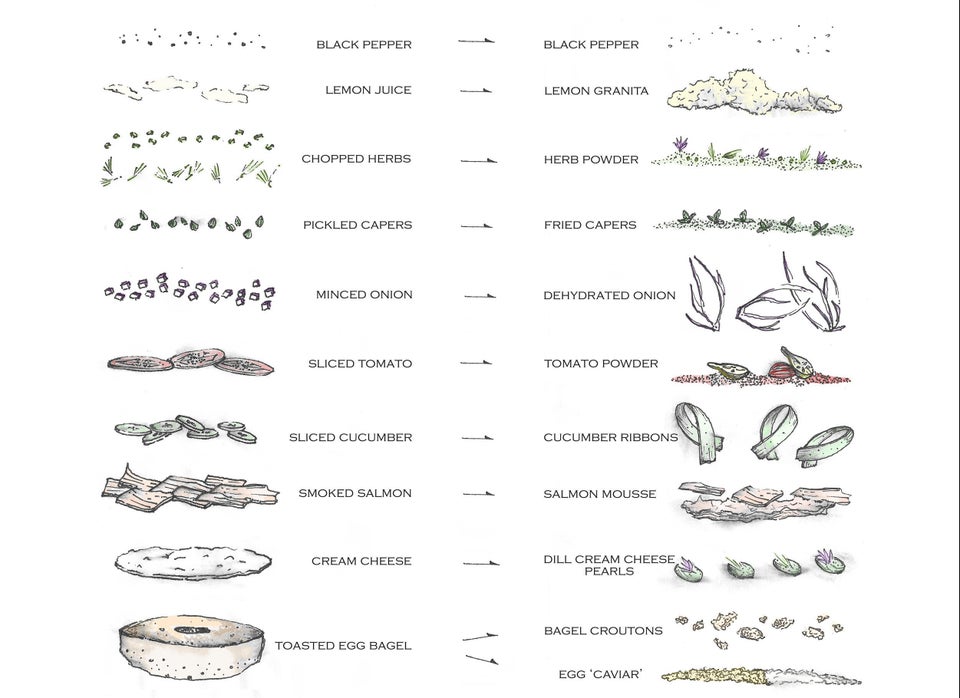Many consider modernist cuisine industrialized food on a small scale -- cheese puffs and flavored foams. However, the modernist movement provides new ways to improve upon classic dishes.
Nathan Myhvold's (former Microsoft CTO) 6-volume, 2438-page encyclopedia "Modernist Cuisine" (modernistcuisine.com) is the best book on this topic to date. The enormous and controversial book is brilliant in its research and presentation, regardless of what "Debbie-downer" traditionalists pontificate.
Flipping through the pages took me back to my own 'modernist cuisine' baptism. Ten years ago I was in Spain at the epicenter of this gastronomical movement. My boss at the time was Chef Josep Armenteros. At merely 23-years-old, Josep was a published author, sought after speaker and culinary wunderkind. Donning black Prada shoes, a bulky D-Squared belt, tanned and brimming with confidence, Josep danced while working in the kitchen. He never had a stain on his pressed white chef's coat, never even needed to wear an apron.
One morning I got to work and found Josep waltzing around the pastry kitchen singing loudly to himself. He had two martini glasses in front of him. Spaniards love to drink and sometimes don't take work as seriously as play. However, 8:30 AM seemed a bit early for cocktails.
Still half asleep, I stood for a moment watching Josep; he looked like he had been awake for hours. "Brooks, leave me alone!" he said smirking without even making eye contact. Josep was busy in his element.
I returned to my workstation and prepared for a long day. Suddenly, Josep appeared with two smoking cocktails. They smelled of burnt sugar and looked foamy and bright yellow.
"Toma!" he said forcing one of the cocktails into my hand.
"No thank you..." he cut me off and handed me a spoon.
"Cómetelo!" he ordered.
My spoon shattered the thin plate of burnt sugar and plunged into the airy foam. Josep mimed to scoop all the way to the bottom of the glass. I lifted the yellow froth, coffee colored lumps, cloudy syrup, and crystal shards into my open mouth. Josep raised his eyebrows in anticipation. I immediately identified the flavors: Cream. Caramel. Orange peel. Lemon. Egg. Burnt sugar.
"It tastes just like crema catalana!"
"No!" Josep retorted, "It is crema catalana!"
I thought crema catalana was essentially a Spanish version of crème brulée; pudding textured dessert, cooked in a water bath, served in a ramekin, topped with burnt sugar. Josep deconstructed the classic dessert applying new techniques to the original recipe. The dessert reminded me of a classic crema calatala but had more depth and texture - hot, cold, crispy, creamy, jellied.
Josep disappeared for a moment, and then returned with a shot glass of sweet bright green alcohol.
"It goes great with a little shot of orujo de hierbas." Josep tilted his head back a chuckled.
And there I was, having my first shot and dessert before breakfast. Viva España!
The concept of deconstruction - applying new cooking techniques to classic recipes is the foundation for "modernist" cuisine. In this slide show I have taken one of my favorite Sunday brunches - bagel, lox and cream cheese - and applied this philosophy to the dish. The result is my expression of a classic.
Enjoy!
